Supersymmetry & Grand Unification: Lecture 7
TLDRThe transcript appears to be a detailed lecture on supersymmetry, a concept in theoretical physics that proposes a relationship between fermions and bosons—two fundamental classes of particles. The lecturer delves into the mathematical formalism behind supersymmetry, discussing the creation and annihilation operators for these particles, and the Lagrangian formulation for both fermions and bosons. The lecture explores the complexities of constructing a Lagrangian that preserves supersymmetry, which ensures that fermions and bosons have the same mass and are part of a symmetrical system. The lecturer also touches upon the challenges of spontaneous symmetry breaking and the implications for particle physics, including the potential existence of superpartners for known particles. The summary emphasizes the intricate mathematical framework of supersymmetry and its profound impact on our understanding of particle interactions, while acknowledging the frustration and complexity involved in fully grasping the subject.
Takeaways
- 🚀 **Fermions and Bosons**: The lecture discusses fermions and bosons at rest, using creation and annihilation operators to describe their existence without considering momentum.
- 🧬 **Quantum Fields**: Introduces the concept of quantum fields for bosons and fermions, highlighting the Lagrangian formulation that is analogous to a single harmonic oscillator.
- ⚙️ **Lagrangian and Hamiltonian**: Explains how the energy of a system can be described using the mass times the number of quanta for bosons and a similar pattern for fermions.
- 🌀 **Supersymmetry (SUSY)**: Delves into the symmetry between fermions and bosons, where supersymmetry allows for the interchange or transformation between these two types of particles.
- 🔍 **Superspace**: Introduces the idea of superspace, which includes additional Grassmann coordinates, expanding the concept of spacetime to include these new dimensions.
- 📐 **Superfields and Superlagrangians**: Describes superfields as functions of time and the new Grassmann coordinates, with superlagrangians being integrals over these new coordinates.
- 🔗 **Transformations and Invariance**: Emphasizes the importance of constructing lagrangians that preserve supersymmetry, meaning that the bosons and fermions have the same mass and the theory is invariant under supersymmetry transformations.
- ⚖️ **Chiral Superfields**: Introduces chiral superfields that satisfy a constraint making them invariant under supersymmetry transformations, which is crucial for building supersymmetric lagrangians.
- 🧲 **Cancellations and Divergences**: Supersymmetric lagrangians ensure exact cancellations to all orders, preventing divergent self-energy of bosons, a significant result of the symmetry between fermions and bosons.
- 🔬 **Particle Physics Implications**: Supersymmetry, if proven, would have profound implications for particle physics, including the existence of superpartners for known particles and constraints on their interactions.
- 🔍 **Spontaneous Symmetry Breaking**: Touches on the concept of spontaneous symmetry breaking in supersymmetry, which is necessary to explain why superpartners are not observed with the same mass as their standard model counterparts.
Q & A
What are fermions and bosons in the context of quantum mechanics?
-Fermions and bosons are two fundamental classes of particles in quantum mechanics. Fermions obey the Pauli exclusion principle and are particles with half-integer spins, including electrons, protons, and neutrons. Bosons, on the other hand, have integer spins and can occupy the same quantum state simultaneously, examples include photons and gluons.
What is the significance of creation and annihilation operators in quantum field theory?
-Creation and annihilation operators are essential tools in quantum field theory. They are used to describe the quantum states of particles. A creation operator adds a particle to a state, while an annihilation operator removes a particle from a state. These operators are crucial for understanding particle interactions and the dynamics of quantum systems.
How does the Lagrangian formulation for fermions differ from that of bosons?
-The Lagrangian formulation for fermions is simpler in the sense that it involves only the first power of the field and its time derivative, unlike bosons which may involve higher powers and more complex interactions. Fermions also involve Grassmann variables, which anti-commute, leading to different mathematical properties and symmetries compared to bosons.
What is supersymmetry and how is it represented in the Lagrangian?
-Supersymmetry is a theoretical concept that proposes a symmetry between fermions and bosons. In the context of the Lagrangian, supersymmetry is represented by a symmetry that allows the transformation of a fermion into a boson and vice versa without changing the energy of the system. This symmetry is described by supercharges, which are conserved quantities and part of an algebra that includes the Hamiltonian.
What are Grassmann numbers and how do they relate to fermions?
-Grassmann numbers are mathematical objects used in the field of quantum mechanics, particularly in the description of fermions. They are anti-commuting variables, meaning that the order of their multiplication matters and they satisfy the property that any Grassmann number squared is zero. Fermions, which are particles with half-integer spins, are described using Grassmann variables in the Lagrangian formulation.
How does the concept of chiral superfields relate to supersymmetry?
-Chiral superfields are a key component in supersymmetry. They are superfields that satisfy a constraint, known as the chirality condition, which states that the superfield is a function only of a specific combination of the new Grassmann coordinates and time. This constraint ensures that the superfield is invariant under supersymmetry transformations, making chiral superfields a suitable building block for supersymmetric Lagrangians.
What are the implications of supersymmetry for particle physics?
-Supersymmetry, if proven true, would have profound implications for particle physics. It predicts the existence of superpartners for every known particle, with the superpartners being bosons for fermions and fermions for bosons. This could solve several problems in physics, such as the hierarchy problem and providing a candidate for dark matter. However, as of the knowledge cutoff in 2023, no superpartners have been observed experimentally.
What is the role of the Hamiltonian in the context of the Lagrangian?
-The Hamiltonian is a function that describes the total energy of a system and plays a crucial role in the Lagrangian formulation of classical mechanics and quantum mechanics. It is related to the Lagrangian by the Legendre transformation. In the context of quantum field theory, the Hamiltonian density is often the term in the Lagrangian that is used to calculate the energy of the quantum fields.
How does the concept of supersymmetry help in addressing the divergences in quantum field theory?
-Supersymmetry can help address divergences in quantum field theory by providing a symmetry that relates bosons and fermions. This symmetry can lead to cancellations between the divergences that arise in calculations involving virtual particles. For instance, the self-energy divergences of bosons can be canceled by the corresponding divergences of their fermionic superpartners, leading to a more consistent theory.
What is the significance of the supersymmetry algebra in theoretical physics?
-The supersymmetry algebra is significant because it encodes the fundamental rules governing the behavior of supersymmetry transformations. It includes the anti-commutation relations between supercharges and other generators, such as the Hamiltonian. This algebra is essential for constructing supersymmetric models and understanding the properties of supersymmetric particles.
What is the process of integrating out the Grassmann coordinates in a supersymmetry Lagrangian?
-Integrating out the Grassmann coordinates in a supersymmetry Lagrangian involves performing an integral over the Grassmann variables θ and θ-bar. This process effectively projects out the component of the Lagrangian that is linear in these variables, which corresponds to the ordinary, non-supersymmetric part of the Lagrangian that governs the dynamics of the system.
Outlines
😀 Fermions and Bosons: Creation and Annihilation
The paragraph discusses fermions and bosons at rest, described by creation and annihilation operators. It explains how to create or annihilate particles using these operators, and how the energy of a bosonic system can be calculated using the mass of the particle and the number of quanta. The text also touches on fermions, their similar treatment with creation and annihilation operators, and the Hamiltonian. It then delves into the Lagrangian formulation for both fermions and bosons, drawing parallels to the mathematics of a harmonic oscillator.
😉 Lagrangian for Fermions and the Role of Grassmann Numbers
This section explores the Lagrangian for fermions, which is simpler than for bosons, involving only the first power of the time derivative. The paragraph discusses the implications of a Lagrangian being a total time derivative and how it affects the equations of motion. It also explains how fermions, treated as Grassmann numbers, alter the Lagrangian and the resulting equations of motion, leading to more restrictive solutions. The potential addition of a term to the Lagrangian to make the system oscillate is also mentioned.
🎓 Supersymmetry and the Algebra of Supercharges
The paragraph introduces supersymmetry, a symmetry between fermions and bosons, and outlines the supersymmetry algebra involving supercharges. It explains how the supercharges, denoted by Q and Q dagger, operate and satisfy an anti-commutator algebra. The importance of the Hamiltonian in relation to the supercharges and the concept of Grassmann dimensions in spacetime are also discussed. The paragraph concludes with the representation of supersymmetry as a shift symmetry in these Grassmann coordinates.
📚 Constructing Supersymmetric Lagrangians
This section focuses on the construction of supersymmetric Lagrangians, which are invariant under supersymmetry transformations. The paragraph explains how to build expressions involving superfields, including squaring the superfield to create another superfield. It also discusses the integration over Grassmann coordinates and the significance of the last term in the superfield expansion for constructing ordinary Lagrangians. The importance of preserving supersymmetry at every stage is emphasized.
🔍 Exploring Chiral Superfields and Constraints
The paragraph delves into chiral superfields, which are superfields that satisfy a constraint making them invariant under supersymmetry transformations. It discusses the construction of such fields and their properties, particularly how they transform under supersymmetry. The concept of a chiral superfield is tied to a new variable 'tau', which is a shifted version of time, combining time and Grassmann coordinates. The text also explores the expansion of these chiral superfields and their potential use in Lagrangians.
🧠 The Complexity and Implications of Supersymmetry
The final paragraph addresses the complexity of supersymmetry and its implications for particle physics. It touches on the frustration of teaching and learning supersymmetry due to its abstract nature and the need for a deep understanding of its formalism. The text discusses the experimental search for supersymmetric particles at facilities like the LHC and how their interactions and properties are determined by supersymmetry. It concludes with a reflection on the tediousness of the subject and the dedication required to master it.
Mindmap
Keywords
💡Fermions
💡Bosons
💡Creation and Annihilation Operators
💡Lagrangian Formulation
💡Supersymmetry
💡Grassmann Numbers
💡Quantum Mechanics
💡Hamiltonian
💡Harmonic Oscillator
💡Space-Time
💡Chiral Superfield
Highlights
The lecture discusses fermions and bosons at rest, described by creation and annihilation operators, focusing on their presence rather than momentum.
Introduction of creation and annihilation operators for bosons, denoted as a plus and a minus, and their relation to the mass and energy of the particle.
The energy of the bosonic system is given by the mass times the number of quanta, a fundamental principle in quantum mechanics.
If fermions and bosons have the same energy or mass, the number of fermions can be added to the number of bosons to define the energy or Hamiltonian of the system.
The Lagrangian formulation of bosons and fermions is explored, emphasizing the mathematical structure of a harmonic oscillator for bosons.
The field theory for bosons is simplified to a harmonic oscillator model, leading to oscillating solutions with a frequency dependent on the mass.
Fermions are described by a Lagrangian that involves only the first power of the time derivative, contrasting with the bosonic case.
The Lagrangian for fermions is shown to be simpler and involves Grassmann variables, which are crucial for the quantum mechanics of fermions.
Supersymmetry is introduced as a symmetry between fermions and bosons, allowing for the exchange of one for the other without changing the energy.
Supersymmetric transformations are defined by operators Q and Q dagger, which satisfy an anti-commutator algebra, a key characteristic of supersymmetry.
The concept of Grassmann dimensions is introduced to spacetime, adding a new layer of complexity to the understanding of supersymmetry.
The supersymmetry algebra is closed, indicating that the system is consistent and conserved quantities can be identified, known as supercharges.
The lecture touches on the idea of supersymmetry as a generalization of space-time symmetry, suggesting a deeper structure to physical laws.
The construction of super Lagrangians is detailed, which are essential for building actions that preserve supersymmetry in physical systems.
Chiral superfields, which satisfy a constraint involving derivatives with respect to certain superspace coordinates, are introduced and shown to be invariant under supersymmetry transformations.
The potential implications of supersymmetry for particle physics are discussed, including the possibility of superpartners for known particles.
The lecture concludes with a discussion on the technical and formal nature of supersymmetry, highlighting the complexity and frustration involved in understanding the theory.
Transcripts
Browse More Related Video
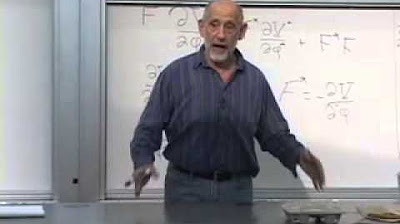
Supersymmetry & Grand Unification: Lecture 9

Supersymmetry & Grand Unification: Lecture 4
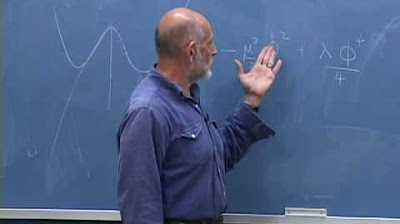
Lecture 10 | New Revolutions in Particle Physics: Standard Model
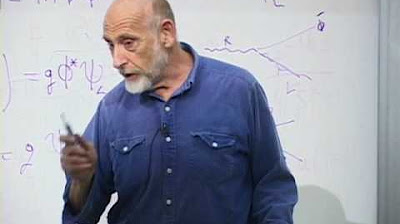
Lecture 9 | New Revolutions in Particle Physics: Standard Model
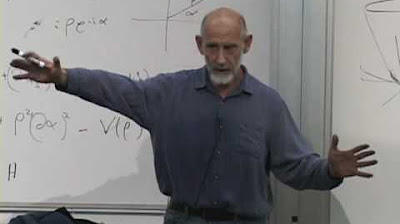
Lecture 8 | New Revolutions in Particle Physics: Standard Model
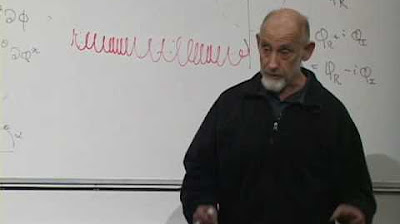
Lecture 7 | New Revolutions in Particle Physics: Standard Model
5.0 / 5 (0 votes)
Thanks for rating: